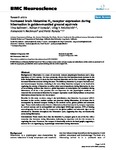Increased brain histamine H-3 receptor expression during hibernation in golden-mantled ground squirrels
| dc.contributor.author | Sallmen, T | |
| dc.contributor.author | Lozada, AF | |
| dc.contributor.author | Anichtchik, Oleg | |
| dc.contributor.author | Beckman, AL | |
| dc.contributor.author | Panula, P | |
| dc.date.accessioned | 2016-04-14T20:32:11Z | |
| dc.date.available | 2016-04-14T20:32:11Z | |
| dc.date.issued | 2003 | |
| dc.identifier.issn | 1471-2202 | |
| dc.identifier.issn | 1471-2202 | |
| dc.identifier.other | ARTN 24 | |
| dc.identifier.uri | http://hdl.handle.net/10026.1/4503 | |
| dc.description.abstract |
BACKGROUND: Hibernation is a state of extremely reduced physiological functions and a deep depression of CNS activity. We have previously shown that the histamine levels increase in the brain during hibernation, as does the ratio between histamine and its first metabolite, suggesting increased histamine turnover during this state. The inhibitory histamine H3 receptor has both auto- and heteroreceptor function, rendering it the most likely histamine receptor to be involved in regulating the activity of histamine as well as other neurotransmitters during hibernation. In view of accumulating evidence that there is a global depression of transcription and translation during hibernation, of all but a few proteins that are important for this physiological condition, we reasoned that an increase in histamine H3 receptor expression would clearly indicate an important hibernation-related function for the receptor. RESULTS: In this study we show, using in situ hybridization, that histamine H3 receptor mRNA increases in the cortex, caudate nucleus and putamen during hibernation, an increase that is accompanied by elevated receptor binding in the cerebral cortex, globus pallidus and substantia nigra. These results indicate that there is a hibernation-related increase in H3 receptor expression in cortical neurons and in striatopallidal and striatonigral GABAergic neurons. GTP-gamma-S binding autoradiography shows that the H3 receptors in the globus pallidus and substantia nigra can be stimulated by histamine throughout the hibernation cycle, suggesting that they are functionally active during hibernation. CONCLUSIONS: These results show that the histamine H3 receptor gene is one of the few with a transcript that increases during hibernation, indicating an important role for the receptor in regulating this state. Moreover, the receptor is functionally active in the basal ganglia, suggesting a function for it in regulating e.g. dopaminergic transmission during hibernation. | |
| dc.format.extent | 24-24 | |
| dc.format.medium | Electronic | |
| dc.language | eng | |
| dc.language.iso | eng | |
| dc.publisher | Springer Science and Business Media LLC | |
| dc.subject | Animals | |
| dc.subject | Autoradiography | |
| dc.subject | Binding, Competitive | |
| dc.subject | Brain | |
| dc.subject | Caudate Nucleus | |
| dc.subject | Cerebral Cortex | |
| dc.subject | Female | |
| dc.subject | Globus Pallidus | |
| dc.subject | Guanosine 5'-O-(3-Thiotriphosphate) | |
| dc.subject | Hibernation | |
| dc.subject | In Situ Hybridization | |
| dc.subject | Neurons | |
| dc.subject | Putamen | |
| dc.subject | RNA, Messenger | |
| dc.subject | Receptors, Histamine H3 | |
| dc.subject | Sciuridae | |
| dc.subject | Substantia Nigra | |
| dc.subject | Up-Regulation | |
| dc.title | Increased brain histamine H-3 receptor expression during hibernation in golden-mantled ground squirrels | |
| dc.type | journal-article | |
| dc.type | Journal Article | |
| dc.type | Research Support, Non-U.S. Gov't | |
| plymouth.author-url | https://www.webofscience.com/api/gateway?GWVersion=2&SrcApp=PARTNER_APP&SrcAuth=LinksAMR&KeyUT=WOS:000186545300001&DestLinkType=FullRecord&DestApp=ALL_WOS&UsrCustomerID=11bb513d99f797142bcfeffcc58ea008 | |
| plymouth.issue | 1 | |
| plymouth.volume | 4 | |
| plymouth.publication-status | Published | |
| plymouth.journal | BMC Neuroscience | |
| dc.identifier.doi | 10.1186/1471-2202-4-24 | |
| plymouth.organisational-group | /Plymouth | |
| plymouth.organisational-group | /Plymouth/Faculty of Health | |
| plymouth.organisational-group | /Plymouth/REF 2021 Researchers by UoA | |
| plymouth.organisational-group | /Plymouth/REF 2021 Researchers by UoA/UoA01 Clinical Medicine | |
| plymouth.organisational-group | /Plymouth/REF 2021 Researchers by UoA/UoA01 Clinical Medicine/UoA01 Clinical Medicine | |
| plymouth.organisational-group | /Plymouth/Research Groups | |
| plymouth.organisational-group | /Plymouth/Research Groups/Institute of Translational and Stratified Medicine (ITSMED) | |
| plymouth.organisational-group | /Plymouth/Research Groups/Institute of Translational and Stratified Medicine (ITSMED)/CBR | |
| plymouth.organisational-group | /Plymouth/Users by role | |
| plymouth.organisational-group | /Plymouth/Users by role/Researchers in ResearchFish submission | |
| dc.publisher.place | England | |
| dcterms.dateAccepted | 2003-09-24 | |
| dc.identifier.eissn | 1471-2202 | |
| dc.rights.embargoperiod | Not known | |
| rioxxterms.versionofrecord | 10.1186/1471-2202-4-24 | |
| rioxxterms.licenseref.uri | http://www.rioxx.net/licenses/all-rights-reserved | |
| rioxxterms.licenseref.startdate | 2003-09-24 | |
| rioxxterms.type | Journal Article/Review |


